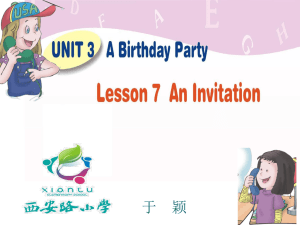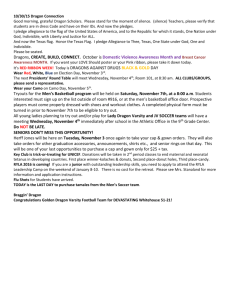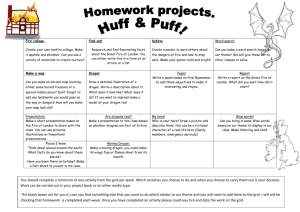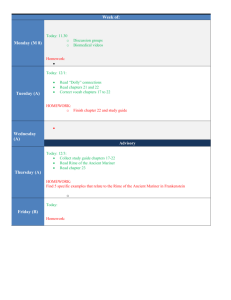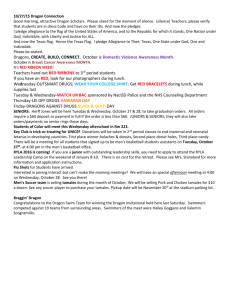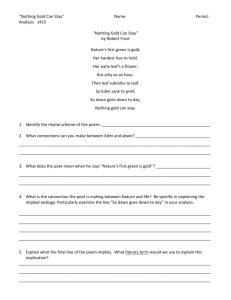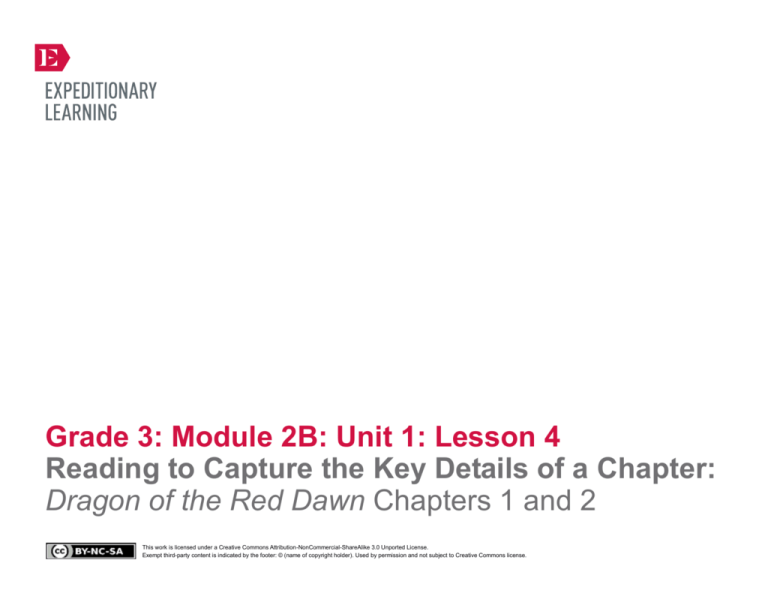
Grade 3: Module 2B: Unit 1: Lesson 4
Reading to Capture the Key Details of a Chapter:
Dragon of the Red Dawn Chapters 1 and 2
This work is licensed under a Creative Commons Attribution-NonCommercial-ShareAlike 3.0 Unported License.
Exempt third-party content is indicated by the footer: © (name of copyright holder). Used by permission and not subject to Creative Commons license.
GRADE 3: MODULE 2B: UNIT 1: LESSON 4
Reading to Capture the Key Details of a Chapter:
Dragon of the Red Dawn Chapters 1 and 2
Long-Term Targets Addressed (Based on NYSP12 ELA CCLS)
I can retell a chapter in a story using key details from the text. (RL.3.2)
I can answer questions using specific details from literary text. (RL.3.1)
I can effectively participate in a conversation with my peers and adults. (SL.3.1)
I can document what I learn about a topic by sorting evidence into categories. (W.3.8)
I can document what I learn about a topic by taking notes. (W.3.8)
Supporting Learning Targets
Ongoing Assessment
• I can determine the key details of Chapters 1 and 2 by identifying the important parts of the chapter
(who/where/what).
• Capturing Key Details recording form: Dragon of the
Red Dawn Chapter 2
• I can identify and record key details in Chapter 2 that connect with evidence of ancient Japan’s culture.
Copyright © 2013 by Expeditionary Learning, New York, NY. All Rights Reserved.
NYS Common Core ELA Curriculum • G3:M2B:U1:L4 • June 2014 •
1
GRADE 3: MODULE 2B: UNIT 1: LESSON 4
Reading to Capture the Key Details of a Chapter:
Dragon of the Red Dawn Chapters 1 and 2
Agenda
Teaching Notes
1. Opening
• In this lesson, students begin reading Magic Tree House: Dragon of the Red Dawn together. Based on
the needs of your class, this “launch” lesson may run longer than 60 minutes. Consider continuing at
another time during the day, or breaking this lesson into two class sessions.
A. Engaging the Reader: Taking a Book Walk of
Dragon of the Red Dawn (8 minutes)
B. Unpacking Learning Targets (2 minutes)
2. Work Time
A. Reading Chapter 1 and Introducing
Where/Who/What (10 minutes)
B. Reading Chapter 2 and Introducing Capturing Key
Details (15 minutes)
C. Tracking Evidence of Culture through Chapter 2 (20
minutes)
3. Closing and Assessment
A. Debrief: Jack’s Research Book (5 minutes)
4. Homework
A. Tell someone at home about the chapters we read
today.
B. Explain to someone at home how Dragon of the Red
Dawn will help you learn about the culture of
ancient Japan.
• When launching this historical fiction chapter book, it is important to emphasize to students how the
author did research before crafting the story. This module uses the Magic Tree House book both to
introduce students to this highly popular chapter book series by Marty Pope Osborne and as a
“springboard” into learning more about culture. Students do consider the main events in each chapter
(aligned with RL.3.1) and do examine Jack and Annie’s character (with a particular focus on Jack as a
“researcher”). But this module does not involve an extensive study of author’s craft in literary text. As
you launch students’ work with Dragon of the Red Dawn, strive to simultaneously engage students in
the story itself and begin to lay the groundwork that stories like the Magic Tree House books begin with
real research.
• Dragon of the Red Dawn is number 37 in the Magic Tree House book series. This specific book in the
series was chosen based on its text complexity and on how it connects to the NYS content frameworks
(in terms of helping students learn about culture, specifically customs and traditions). Some students
may have read this text before, and now will be rereading to think about what the story teaches us about
culture in ancient Japan. Other students may be totally new to this series, and may get hooked. Consider
encouraging these students to read other Magic Tree House books during independent reading, perhaps
beginning with book number one.
• This lesson includes a new Structural Features of a Chapter Book (Magic Tree House) anchor chart. This
will be used to contrast with the Structural Features of Informational Text anchor chart later in the unit.
Be sure to clarify for students that not all chapter books have identical structures: This anchor chart is
just to give a general sense of how the Magic Tree House books are structured differently from the
informational texts students will read later.
• In advance: Preview the final performance task (see separate stand-alone teacher-facing document) to
understand more fully the research-based letter students will write to Mary Pope Osborne.
• Throughout the module, students can work in reading partnerships to support struggling readers. For
students who need even more support, consider the following:
Copyright © 2013 by Expeditionary Learning, New York, NY. All Rights Reserved.
NYS Common Core ELA Curriculum • G3:M2B:U1:L4 • June 2014 •
2
GRADE 3: MODULE 2B: UNIT 1: LESSON 4
Reading to Capture the Key Details of a Chapter:
Dragon of the Red Dawn Chapters 1 and 2
Agenda
Teaching Notes (continued)
1. Pull several partnerships together for guided support during their reading.
2. Devote an instructional aide or another adult’s time to supporting students while they read the
chapters aloud. This gives students guidance for both decoding and comprehension.
3. After students have made a first attempt on their own, find another time in the day to review
sticking points they had and support their comprehension.
• Certain chapters of Dragon of the Red Dawn are designated to be read as homework. For students
needing more support, arrange for other accommodations (e.g. support from a teaching aide during
another part of the school day), so they do not fall behind on the reading.
• Consider preparing audio recordings of the texts used in the module.
• There are many methods of checking for understanding whether individual students have met a
learning target. Fist to Five is one common technique. Other engaging, quick techniques include:
Thumb-O-Meter; Glass, Bugs, Mud; Red Light, Green Light; Sticky Bars; Learning Line-ups; Human
Bar Graph; and Table Tags. Depending on the purpose, any of these techniques can be used for students
to self-assess their level of understanding while also letting you check their progress. For descriptions,
see Checking for Understanding Techniques in the Appendix.
• In advance:
– Create Structural Features of a Chapter Book (Magic Tree House) anchor chart.
– Consider preparing the Mary Pope Osborne quote on a chart to display throughout the module.
– Review: Think-Pair-Share protocol and cold call in Checking for Understanding Techniques (see
Appendix).
• Post: Learning targets.
Copyright © 2013 by Expeditionary Learning, New York, NY. All Rights Reserved.
NYS Common Core ELA Curriculum • G3:M2B:U1:L4 • June 2014 •
3
GRADE 3: MODULE 2B: UNIT 1: LESSON 4
Reading to Capture the Key Details of a Chapter:
Dragon of the Red Dawn Chapters 1 and 2
Lesson Vocabulary
Materials
ancient, prologue, historical fiction,
setting, characters, events, custom,
tradition, passport, imperial
• Document camera
• Dragon of the Red Dawn (book; one per student and one for teacher use)
• Mary Pope Osborne quote (one to display)
• Structural Features of a Chapter Book (Magic Tree House) anchor chart (new; teacher-created; see supporting materials)
• Where/Who/What anchor chart (new; teacher-created from Part 1 of the Capturing Key Details recording form)
• Capturing Key Details anchor chart (new; teacher-created from the recording form with this same name)
• Capturing Key Details recording form: Dragon of the Red Dawn Chapter 2 (one per student)
Copyright © 2013 by Expeditionary Learning, New York, NY. All Rights Reserved.
NYS Common Core ELA Curriculum • G3:M2B:U1:L4 • June 2014 •
4
GRADE 3: MODULE 2B: UNIT 1: LESSON 4
Reading to Capture the Key Details of a Chapter:
Dragon of the Red Dawn Chapters 1 and 2
Opening
Meeting Students’ Needs
A. Engaging the Reader: Taking a Book Walk of Dragon of the Red Dawn (8 minutes)
• Using a document camera, project the cover of the book Dragon of the Red Dawn. Ask students to indicate whether they
are familiar with this series. Consider inviting a few students to share what they know about the Magic Tree House books.
• Using total participation techniques
such as cold call or equity sticks
encourages a wider range of voices
in whole class shares.
• Do not give too much about the book away: just tell students that this literary text is one that many young people have loved.
It is one of many books written by Mary Pope Osborne about a brother and sister who go on exciting adventures. Mary Pope
Osborne wanted to create an exciting chapter books for readers. While they read this book, students get to think about these
adventures, including getting to learn about different cultures by reading about how Jack and Annie interact with the people,
the customs, and the traditions in that country. Introduce the concept of historical fiction (which will be reinforced
throughout the module): this is an imaginary story set in a real time and place.
• Tell students that the setting of Dragon of the Red Dawn is ancient Japan. Clarify briefly for students the meaning of the
word ancient.
• Point out that the author, Mary Pope Osborne, always did a lot of research about the countries where her books take place.
Project the Dear Reader letter from Mary Pope Osborne (precedes the table of contents). Read the letter aloud to students.
• Then, highlight this Mary Pope Osborne quote by reading it aloud again:
* “I wanted to live in the scenes the artists created. I wanted to ride on the fishing boat, sip tea in a teahouse, see cherryblossom petals float down a river. When I’m writing a book, I feel as if I am living in another place and time.”
• Have students Think-Pair-Share:
* “How can this chapter book help you learn about ancient Japan’s culture?”
• Gather students whole group. Distribute one copy of Dragon of the Red Dawn to each student. Tell students this is the
special book that they will read together. For the first two chapters, they follow along as the text is read aloud to them. In
future chapters, they will get to read the text on their own.
• Invite students to take a Book Walk. Encourage them to notice the book’s structure by flipping through pages, noticing
chapter headings and illustrations. Tell students they won’t be reading the book right now but may be pausing at places that
look interesting.
• Invite students to Think-Pair-Share:
* “What did you notice about the structure of this book?”
Copyright © 2013 by Expeditionary Learning, New York, NY. All Rights Reserved.
NYS Common Core ELA Curriculum • G3:M2B:U1:L4 • June 2014 •
5
GRADE 3: MODULE 2B: UNIT 1: LESSON 4
Reading to Capture the Key Details of a Chapter:
Dragon of the Red Dawn Chapters 1 and 2
Meeting Students’ Needs
Opening (continued)
• Students likely will notice things like the prologue, the letter from the author, the table of contents (with titled chapters),
illustrations in each chapter, and additional information and activities (at the back). Chart students’ responses on a new
Structural Features of a Chapter Book (Magic Tree House) anchor chart. Clarify as needed the purpose or role of
these different structural components. (Keep this chart posted. Students will revisit it again specifically in Lesson 8 when
they do a Book Walk with the informational text Exploring Countries: Japan.)
• Direct students’ attention to the prologue. Ask if any students know what this word means; define it for them if necessary.
Briefly explain the purpose of prologues in general and why this prologue specifically is important. (Since this is number 37
in the Magic Tree House series, students need to have the background that is established in the prologue to set the scene of
this new adventure for Jack and Annie. (See Teaching Notes.)
• Read the prologue aloud to students. To avoid confusion, briefly review the characters mentioned in the prologue. Ask:
* “Who are Jack and Annie? (the main characters who live in Frog Creek, Pennsylvania, and travel to real places back in
time)
* “Who are Teddy and Kathleen?” (young sorcerers who assist Morgan le Fay)
* “Who is Morgan le Fay?” (the magical librarian from the legendary realm of Camelot)
* “Who is Merlin?” (the magician of Camelot)
B. Unpacking Learning Targets (2 minutes)
• Read the targets aloud or invite a volunteer to do so.
* “I can determine the key details of Chapters 1 and 2 by identifying the important parts of the chapter (who/where/what).”
* “I can identify and record key details in Chapter 2 that connect with evidence of ancient Japan’s culture.”
• Then invite students to talk with a partner about today’s work as readers.
• Focus students whole group. Ask students to discuss what they think they might do to reach the first target. Help students
identify that they will read Chapter 1 of Dragon of the Red Dawn so they can think about the important parts of this chapter.
• Point out that the second target relates to the work students have been doing with culture and finding evidence of culture in
Lessons 2 and 3.
• Use Fist to Five as a check for understanding of these two learning targets.
Copyright © 2013 by Expeditionary Learning, New York, NY. All Rights Reserved.
NYS Common Core ELA Curriculum • G3:M2B:U1:L4 • June 2014 •
6
GRADE 3: MODULE 2B: UNIT 1: LESSON 4
Reading to Capture the Key Details of a Chapter:
Dragon of the Red Dawn Chapters 1 and 2
Work Time
Meeting Students’ Needs
A. Reading Chapter 1 and Introducing Where/Who/What (10 minutes)
• Ask students to read along in their books as you read Chapter 1 aloud, fluently, with expression, and without interruption.
• Reading aloud to students as they
read along helps build their fluency.
ELLs and struggling ELA students
benefit from hearing a text read
aloud before they read it on their
own.
• Display the Where/Who/What anchor chart. Explain to students that when reading a chapter book, it’s important for
readers to keep track of important parts of the chapter: where the action is (setting), who the important characters are, and
what the most important events are. Clarify the meaning of the words setting, characters, and events as needed. Explain to
students that they will be using a two-part recording form as they read Dragon of the Red Dawn. This recording form will be
an important tool to help them follow the story as it unfolds chapter by chapter. Point out to students that Part 1 of that
recording form looks just like this anchor chart.
• Taking the questions one at a time, ask students to Think-Pair-Share:
• All students developing academic
language will benefit from direct
instruction of academic vocabulary.
• Consider allowing students to draw
their observations, ideas, or notes
when appropriate. This allows all
students to participate in
meaningful way.
* “What is the setting of this chapter? In other words, when and where does this chapter take place?”
* “Who are the important characters in the chapter?”
* “What are the most important events in this chapter? In other words, what happens?”
• As students share, record their responses on the Where/Who/What anchor chart.
• Tell students that you want them to really get familiar with this chart, since it is just like part of a recording form they will be
using (Part 1 of the Capturing Key Details recording form) in Work Time B. Ask students to look over the anchor chart and
then discuss:
* “In looking at this anchor chart, do you feel the information that we wrote captures the key details of Chapter 1?”
• Provide nonlinguistic symbols (e.g.,
a person for character) to assist
ELLs and other struggling readers
in making connections with the
headings on the Where/Who/What
anchor chart.
• The anchor chart provides a model
of expected work. This supports all
students but especially supports
challenged learners.
Copyright © 2013 by Expeditionary Learning, New York, NY. All Rights Reserved.
NYS Common Core ELA Curriculum • G3:M2B:U1:L4 • June 2014 •
7
GRADE 3: MODULE 2B: UNIT 1: LESSON 4
Reading to Capture the Key Details of a Chapter:
Dragon of the Red Dawn Chapters 1 and 2
Meeting Students’ Needs
Work Time (continued)
B. Reading Chapter 2 and Introducing Capturing Key Details (15 minutes)
• Tell students that you will now read Chapter 2 aloud as they again follow along. Invite them to keep the where/who/what
categories in mind as they listen. After they read the chapter, they will again work together to complete the chart.
• Read Chapter 2 aloud, fluently, with expression, and without interruption. Stop at page 15 after the word passports is
mentioned the first time to briefly ask:
* “Think about where the chapter is taking place right now. Is it the same as Chapter 1? What are passports?”
• Make sure students correctly identify that Jack and Annie are now in ancient Japan in a beautiful garden (the Imperial
Garden) outside the Imperial Palace. Define imperial for students: “Imperial” means that it relates to emperors or empires.
It is something for kings, queens, or emperors. Finish reading the remaining pages of Chapter 2 without any additional
stops.
• Display the Capturing Key Details anchor chart and ask students what they notice. Listen for them to recognize that
the upper part of this anchor chart is the Where/Who/What anchor chart used earlier with Chapter 1.
• Distribute the Capturing Key Details recording form: Dragon of the Red Dawn Chapter 2 to students (which
looks exactly like the anchor chart).
• Work with students to fill out Part 1 of the recording form for Chapter 2. As suggestions are shared, record them on the
anchor chart for students to copy onto their recording forms.
Copyright © 2013 by Expeditionary Learning, New York, NY. All Rights Reserved.
NYS Common Core ELA Curriculum • G3:M2B:U1:L4 • June 2014 •
8
GRADE 3: MODULE 2B: UNIT 1: LESSON 4
Reading to Capture the Key Details of a Chapter:
Dragon of the Red Dawn Chapters 1 and 2
Work Time (continued)
Meeting Students’ Needs
C. Tracking Evidence of Culture through Chapter 2 (20 minutes)
• When reviewing graphic organizers
or recording forms, consider using a
document camera to display the
document for students who struggle
with auditory processing.
• Display and read aloud the Mary Pope Osborne quote:
* “Whenever I start work on a new Magic Tree House book, I begin the great adventure of research. I visit libraries, the
Internet, bookstores, and museums. I talk to people who are knowledgeable about my subject, and if I’m able, I visit the
place where the story occurs.” —From Carnival at Candlelight: Author’s Research Note
• Invite students to Think-Pair-Share:
* “What does Mary Pope Osborne do to research a book? If Mary Pope Osborne wanted information about a country’s
culture, what kinds of information might she be looking for?”
• Explain to students that when an author is writing a historical fiction book, he or she must conduct research. A historical
fiction text is one that has made-up characters and plots but takes place in a real, ancient setting. That’s the only way to
guarantee that the information they include as part of the story is accurate and true. Tell students that the author, Mary
Pope Osborne, wanted us to feel like we were in ancient Japan with Jack and Annie. To do that, she had to include accurate
details about what life was like in that time period and what the people living there held dear and considered important. She
had to research before she could write.
• Display the Capturing Key Details anchor chart again. This time, have students focus on Part 2 on the lower half of the
recording form. Ask: “What do you notice?” Direct students to briefly share their observations with a nearby partner.
• Then, ask students to respond to the following question:
* “What kind of information goes in the first column?”
• Remind students that customs and traditions were words they encountered in the Carousel Brainstorm protocol in Lesson 1,
and again in the article they read about culture in Lessons 2 and 3.
• Focus students on the final column and ask:
* “What kind of information goes in the second column?”
Copyright © 2013 by Expeditionary Learning, New York, NY. All Rights Reserved.
NYS Common Core ELA Curriculum • G3:M2B:U1:L4 • June 2014 •
9
GRADE 3: MODULE 2B: UNIT 1: LESSON 4
Reading to Capture the Key Details of a Chapter:
Dragon of the Red Dawn Chapters 1 and 2
Meeting Students’ Needs
Work Time (continued)
• Tell students that you will be reading Chapter 2 aloud a second time, and this time they need to be very actively listening and
looking for evidence of customs or traditions in ancient Japan that Mary Pope Osborne placed within the chapter.
• Show students how to use a silent signal to indicate they heard a custom or tradition. Consider having students put thumbs
at their hearts to signal they heard a custom or tradition in ancient Japan during the second read.
• Begin reading Chapter 2 aloud for a second time. Direct students to use the appropriate hand gesture if they think there is a
custom or tradition mentioned.
• As students offer suggestions, record their responses on the Capturing Key Details anchor chart. Help students become
familiar with the recording form. Direct students to fill in the same information on their recording form that you write on the
anchor chart.
Note: Hold on to this anchor chart for Lesson 7.
Copyright © 2013 by Expeditionary Learning, New York, NY. All Rights Reserved.
NYS Common Core ELA Curriculum • G3:M2B:U1:L4 • June 2014 •
10
GRADE 3: MODULE 2B: UNIT 1: LESSON 4
Reading to Capture the Key Details of a Chapter:
Dragon of the Red Dawn Chapters 1 and 2
Closing and Assessment
Meeting Students’ Needs
A. Debrief: Jack’s Research Book (5 minutes)
• Remind students that Teddy gave Jack and Annie a book called A Journey to Old Japan in Chapter 1. Ask:
• For students needing additional
support producing language,
consider offering a sentence frame
or starter or a cloze sentence to
assist with language production and
provide structure.
* “Why did Teddy give them the book?”
• Listen for students to note that the book was needed to help transport Jack and Annie from Frog Creek Woods,
Pennsylvania, to ancient Japan. But the other reason Teddy gave them the book is because it’s full of information about
where they are: ancient Japan.
• Have students work with a partner to revisit the places in Chapter 2 when Jack is reading information from the book on
Japan. If students are struggling, point out that this is signaled in the text by indentations and bold print.
• Invite a few volunteers to share when in Chapter 2 Jack read from the book on Japan. Encourage students to point to
specific examples.
• Connect back to the learning targets. Remind students that just as Jack and Annie are learning about an ancient culture by
reading a text, we are learning as well by reading about their adventures.
• Reread the learning targets. Ask for a Fist to Five on how students felt they did in meeting the targets today.
Homework
Meeting Students’ Needs
• Tell someone at home about the chapters we read today. (If possible, let students take home their Capturing Key Details
recording form: Dragon of the Red Dawn Chapter 2).
• Consider ways to allow students to
listen to Dragon of the Red Dawn at
home (on audiobooks or read aloud
by a caregiver) as students read
along silently.
• Explain to someone at home how Dragon of the Red Dawn will help you learn about the culture of ancient Japan.
Note: Be sure to emphasize the importance of students returning the book to school the next day.
Copyright © 2013 by Expeditionary Learning, New York, NY. All Rights Reserved.
NYS Common Core ELA Curriculum • G3:M2B:U1:L4 • June 2014 •
11
Grade 3: Module 2B: Unit 1: Lesson 4
Supporting Materials
This work is licensed under a Creative Commons Attribution-NonCommercial-ShareAlike 3.0 Unported License.
Exempt third-party content is indicated by the footer: © (name of copyright holder). Used by permission and not subject to Creative Commons license.
GRADE 3: MODULE 2B: UNIT 1: LESSON 4
Mary Pope Osborne Quote
“Whenever I start work on a new Magic Tree House book, I begin the great
adventure of research. I visit libraries, the Internet, bookstores, and museums. I
talk to people who are knowledgeable about my subject, and if I’m able, I visit
the place where the story occurs.”
—From Carnival at Candlelight: Author’s Research Note
Copyright © 2013 by Expeditionary Learning, New York, NY. All Rights Reserved.
NYS Common Core ELA Curriculum • G3:M2B:U1:L4 • June 2014 •
13
GRADE 3: MODULE 2B: UNIT 1: LESSON 4
Structural Features of a Chapter Book (Magic Tree House) Anchor Chart
(For Teacher Reference)
1. Dedication
2. Dear Reader letter
3. Table of Contents
4. Prologue
5. Chapters with titles
6. Additional information
7. Activities
8. Preview of next book in series
Copyright © 2013 by Expeditionary Learning, New York, NY. All Rights Reserved.
NYS Common Core ELA Curriculum • G3:M2B:U1:L4 • June 2014 •
14
GRADE 3: MODULE 2B: UNIT 1: LESSON 4
Capturing Key Details Recording Form:
Dragon of the Red Dawn Chapter 2
Name:
Date:
Part 1: What are the important parts of the chapter?
Where does this chapter take
place?
Who are the important
characters in this chapter?
What are the most important
events in this chapter?
Part 2: Focusing on Culture
What evidence did you find of customs or traditions in ancient Japan? How do those help you
learn about the culture?
What evidence did you find of a custom or tradition in ancient Japan?
Copyright © 2013 by Expeditionary Learning, New York, NY. All Rights Reserved.
Page in text
NYS Common Core ELA Curriculum • G3:M2B:U1:L4 • June 2014 •
15
GRADE 3: MODULE 2B: UNIT 1: LESSON 4
Capturing Key Details Recording Form:
Dragon of the Red Dawn Chapter 2
(Answers, for Teacher Reference)
Part 1: What are the important parts of the chapter?
Where does this chapter
take place?
Who are the important
characters in this chapter?
What are the most important events
in this chapter?
The Imperial Garden
outside the Imperial
Palace in Edo, Japan
Jack and Annie
Samurai
Jack and Annie arrive in
ancient Japan using the tree
house and use Jack’s research
book to learn a little bit about
where they are.
They discover they need a
passport to travel safely since
outsiders are not welcome in
Japan.
They see a shogun traveling
with his samurai. They decide
to leave the garden and head
into Edo.
They get chased by the samurai
and saved by a man who
pretends to know them.
Part 2: Focusing on Culture
What evidence did you find of customs or traditions in ancient Japan? How do those help you
learn about the culture?
What evidence did you find of a custom or tradition in ancient Japan?
Page in text
wearing kimonos
p. 13
carrying a passport
p. 15
procession of the shogun
p. 16–18
Copyright © 2013 by Expeditionary Learning, New York, NY. All Rights Reserved.
NYS Common Core ELA Curriculum • G3:M2B:U1:L4 • June 2014 •
16


